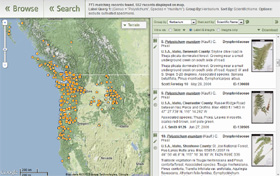Log In
About Us
The Consortium of Pacific Northwest Herbaria was created in 2007 to bring together regional herbaria and provide an online portal to the wealth of existing and emerging information about the flora of Pacific Northwest North America. Over 3.6 million specimen records and numerous online electronic resources are managed by the region's 60 herbaria, representing an irreplacable storehouse of information for research and public education. More...
|
Specimen Data:
Search for herbarium specimens by label data or geographic location. Results show full label data, images of specimens sheets, and a distribution map. Results can also be downloaded or distilled into a species checklist.
Download text files containing the label data for all specimen records in the Consortium database, or for individual herbaria.
See which herbaria provide specimen data to CPNWH, and how many records they provide. Metadata is available for many of the provided datasets.
|
Compiled Resources:
Create species lists for any counties in Washington, Oregon, Idaho, or Montana. Lists can include vascular plants, bryophytes, lichens, algae, and/or fungi.
View or download pre-packaged datasets intended for use on mobile devices without an internet connection. Includes county checklists, distribution maps, and specimen label data.
Collection dot maps for the region, and maps showing geographic coverage by herbarium for ID, MT, OR, and WA.
|
Documentation & Links:
Learn how CPNWH images herbarium specimens. Included are detailed descriptions of our equipment and workflows. Software scripts are available for download.
A comprehensive list of documents and links relevant to digitizing biological collections, particularly herbarium specimens. Maintained by the Consortium of Northeast Herbaria.
An NSF-supported initiative to put into electronic format all records in U.S. collections of biological specimens.
|












